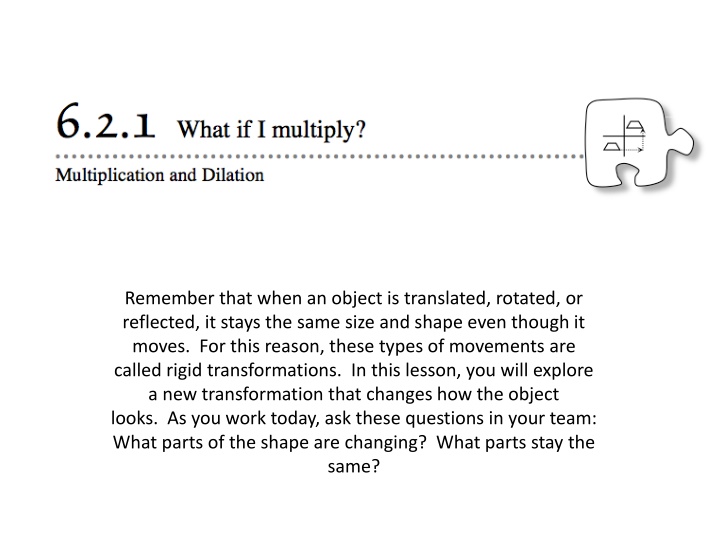
Explore Shape Transformations: Dilations & Investigations
Dive into the world of shape transformations by understanding dilations and investigating how multiplying coordinates affects the graph of a shape. Discover the changes in side lengths, angles, and relationships through practical investigations and discussions with your team.
Download Presentation

Please find below an Image/Link to download the presentation.
The content on the website is provided AS IS for your information and personal use only. It may not be sold, licensed, or shared on other websites without obtaining consent from the author. If you encounter any issues during the download, it is possible that the publisher has removed the file from their server.
You are allowed to download the files provided on this website for personal or commercial use, subject to the condition that they are used lawfully. All files are the property of their respective owners.
The content on the website is provided AS IS for your information and personal use only. It may not be sold, licensed, or shared on other websites without obtaining consent from the author.
E N D
Presentation Transcript
Remember that when an object is translated, rotated, or reflected, it stays the same size and shape even though it moves. For this reason, these types of movements are called rigid transformations. In this lesson, you will explore a new transformation that changes how the object looks. As you work today, ask these questions in your team: What parts of the shape are changing? What parts stay the same?
6-42. When all of the x- or y-coordinates of each vertex of a shape are changed by adding or subtracting the same numbers, the shape translates (slides) to a new position on the coordinate graph. You learned in Lesson 6.1.3 that when one of the coordinates of the vertices (either the x- or y- coordinate) is multiplied by 1, the shape is reflected over the y-axis or the x- axis, respectively. a) How do you think the shape will change when both the x- and y-coordinates are multiplied by some number? Use the directions below to help you answer this question. Plot the following points on graph paper: (2, 1), (3, 1), (5, 5), (2, 5). Connect the points to make a quadrilateral. Without graphing, predict how you think the figure would change if the x- and y-coordinates were multiplied by 2 and then plotted. Test your prediction by doubling the coordinates from part (a) and plotting them on your graph paper. Was your prediction correct? With your team members, look at the figure you just graphed. Transforming a graphed shape by multiplying each coordinate by the same number is called a dilation. With your team, discuss how this figure compares to the original. Be specific about changes in side length and area! b) c) d)
6-43. INVESTIGATING DILATIONS The students in Ms. Stanleys class were studying what happens to the graph of a shape when both coordinates are multiplied by the same number. They came up with these questions: What happens when each coordinate is multiplied by one-half? What changes when the coordinates are multiplied by 1? What happens when both of the coordinates are multiplied by 1? What happens when the coordinates are multiplied by 2?
6-43. INVESTIGATING DILATIONS The students in Ms. Stanleys class were studying what happens to the graph of a shape when both coordinates are multiplied by the same number. They came up with these questions: a) Use the shape at right to investigate the questions above. Use graph paper to make the dilations. b) How did the figure change in each of the investigations? Compare the side lengths, the angles, and the line relationships. Explain what your team learned about the three questions you investigated.
6-44. In problem 6-43, you investigated questions about multiplying coordinates that were posed by other students. a) With your team, write a different question about the effect of multiplying the coordinates of a shape on a grid. This question might start with, What happens when you multiply b) Write a conjecture that is, an educated guess based on the evidence in the last two problems to answer your question. c) On graph paper, investigate your question, and see if your conjecture is supported, by multiplying the coordinates of the shape in problem 6-43 as you described in your question. What happened? Was your conjecture correct?
6-45. LEARNING LOG In your Learning Log, explain how multiplying the coordinates of a shape affects the shape. How does the size of the shape change (or not change)? How do the angles of the shape change (or not change)? Do these results depend on the multiplier that is chosen? Be as specific as you can and include examples to demonstrate your thinking. Title your entry Dilations and include today s date.
